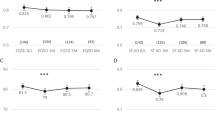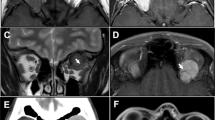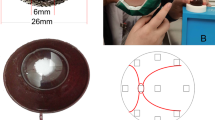Abstract
Purpose
Graves’ orbitopathy (GO) is associated with changes in the appearance of the eyes and visual dysfunction. Patients report feeling socially isolated and unable to continue with day-to-day activities. This study aimed at investigating the demographic, clinical, and psychosocial factors associated with quality of life in patients presenting for orbital decompression surgery.
Methods
One-hundred and twenty-three adults with GO due for orbital decompression at Moorfields Eye Hospital London were recruited prospectively. Clinical measures including treatment history, exophthalmos, optic neuropathy, and diplopia were taken by an ophthalmologist. Participants completed psychosocial questionnaires, including the Graves’ Ophthalmopathy Quality of Life Scale (GO-QOL), the Hospital Anxiety and Depression Scale, and the Derriford Appearance Scale. Hierarchical multiple regression analyses were used to identify predictors of quality of life.
Results
Higher levels of potential cases of clinical anxiety (37%) and depression (26%) were found in this study sample than in patients with other chronic diseases or facial disfigurements. A total of 55% of the variance in GO-QOL visual function scores was explained by the regression model; age, asymmetrical GO and depressed mood were significant unique contributors. In all, 75% of the variance in GO-QOL appearance scores was explained by the regression model; gender, appearance-related cognitions and depressed mood were significant unique contributors.
Conclusion
Appearance-related quality of life and mood were particularly affected in this sample. Predominantly psychosocial characteristics were associated with quality of life. It is important when planning surgery for patients that clinicians be aware of factors that could potentially influence outcomes.
Similar content being viewed by others
Log in or create a free account to read this content
Gain free access to this article, as well as selected content from this journal and more on nature.com
or
References
Bahn RS, Heufelder AE . Pathogenesis of Graves’ ophthalmopathy. N Engl J Med 1993; 329: 1468–1475.
Dickinson AJ Clinical manifestations. In: Wiersinga WM, Kahaly GJ (eds). Graves’ Orbitopathy: A Multidisciplinary Approach — Questions and Answers. Karger: Basel, Switzerland, 2010 pp 1–25.
Jensen AL, Harder I . The impact of bodily change on social behaviour in patients with Thyroid-Associated Ophthalmopathy. Scand J Caring Sci 2011; 25 (2): 341–349.
Kahaly GJ, Hardt J, Petrak F, Egle UT . Psychosocial factors in subjects with thyroid-associated ophthalmopathy. Thyroid 2002; 12 (3): 237–239.
Choi YJ, Lim HT, Lee SJ, Lee SY, Yoon JS . Assessing Graves' ophthalmopathy-specific quality of life in Korean patients. Eye 2012; 26 (4): 544–551.
Ponto KA, Hommel G, Pitz S, Elflein H, Pfeiffer N, Kahaly GJ . Quality of life in a German Graves orbitopathy population. Am J Ophthalmol 2011; 152 (3): 483–490.
Park JJ, Sullivan TJ, Mortimer RH, Wagenaar M, Perry-Keene DA . Assessing quality of life in Australian patients with Graves’ ophthalmopathy. Br J Ophthalmol 2004; 88: 75–78.
Gerding MN, Terwee CB, Dekker FW, Koornneef L, Prummel MF, Wiersinga WM . Quality of life in patients with Graves' ophthalmopathy is markedly decreased: measurement by the medical outcomes study instrument. Thyroid 1997; 7 (6): 885–889.
Kulig G, Andrysiak-Mamos E, Sowinska-Przepiera E, Kulig J, Karakiewicz B, Brodowski J et al. Quality of life assessment in patients with Graves’ disease and progressive infiltrative ophthalmopathy during combined treatment with methylprednisolone and orbital radiotherapy. Endokrynol Pol 2009; 60 (3): 158–165.
Rumsey N, Clarke A, White P, Wyn-Williams M, Garlick W . Altered body image: appearance-related concerns of people with visible disfigurement. J Adv Nurs 2004; 48 (5): 443–453.
Clarke A, Thompson AR, Jenkinson E, Rumsey N, Newell R . CBT for Appearance Anxiety. John Wiley & Sons: Chichester, UK, 2014.
Mourits MP, Prummel MF, Wiersinga WM, Koornneef L . Clinical activity score as a guide in the management of patients with Graves' ophthalmopathy. Clin Endocrinol 1997; 47: 9–14.
Terwee CB, Dekker FW, Mourits MP, Gerding MN, Baldeschi L, Kalmann R et al. Interpretation and validity of changes in scores on the Graves' ophthalmopathy quality of life questionnaire (GO-QOL) after different treatments. Clin Endocrinol (Oxf) 2001; 54 (3): 391–398.
Leary MR . A brief version of the Fear of Negative Evaluation Scale. Personal Soc Psychol Bull 1983; 9 (3): 371–375.
Gibbons FX, Buunk BP . Individual differences in social comparison: development of a scale of social comparison orientation. J Pers Soc Psychol 1999; 76 (1): 129–142.
Zimet GD, Dahlem NW, Zimet SG, Farley GK . The multidimensional scale of perceived social support. J Personal Assess 1988; 52 (1): 30–41.
McBain HB, MacKenzie KA, Hancox J, Ezra DG, Adams GGW, Newman SP . Why do patients with strabismus choose to undergo realignment surgery and what are their expectations of post-surgical outcomes? Development of two questionnaires. Br J Ophthal. under review.
Carr T, Moss TP, Harris DL . The DAS24: a short form of the Derriford Appearance Scale DAS59 to measure individual responses to living with problems of appearance. Br J Health Psychol 2005; 10: 285–298.
Moss TP, Rosser BA . The moderated relationship of appearance valence on appearance self-consciousness: development and testing of new measures of appearance schema components. PLoS One 2012; 7 (11): 1–7.
Zigmond AS, Snaith RP . The hospital anxiety and depression scale. Acta Psychiatr Scand 1983; 67: 361–370 1987.
Cohen J . A power primer. Psychol Bull 1992; 112 (1): 155–159.
Field A . Discovering Statistics Using SPSS. 3rd edn Sage: London, UK, 2009.
Crawford J, Henry J, Crombie C, Taylor EP . Brief report normative data for the HADS from a large non-clinical sample. Br J Clin Psychol 2001; 40 (4): 429–434.
Martin CR, Newell RJ . Factor structure of the Hospital Anxiety and Depression Scale in individuals with facial disfigurement. Psychol Health Med 2004; 9 (3): 327–336.
Rumsey N, Clarke A, White P . Exploring the psychosocial concerns of outpatients with disfiguring conditions. J Wound Care 2003; 12 (7): 247–252.
James H, Jenkinson E, Harrad R, Ezra DG, Newman S . Appearance concerns in ophthalmic patients. Eye 2011; 25: 1039–1044.
McBain H, MacKenzie KA, Au C, Hancox J, Ezra DG, Adams GG et al. Factors associated with quality of life and mood in adults with strabismus. Br J Ophthalmol 2014; 98 (4): 550–555.
Terwee CB, Dekker FW, Bonsel GJ, Heisterkamp SH, Prummel MF, Baldeschi L et al. Facial disfigurement: Is it in the eye of the beholder? A study in patients with Graves' ophthalmopathy. Clin Endocrinol (Oxf) 2003; 58 (2): 192–198.
Klaver EI, van Loon HCM, Stienstra R, Links TP, Keers JC, Kema IP et al. Thyroid hormone status and health-related quality of life in the lifelines cohort study. Thyroid 2013; 23 (9): 1066–1073.
Acknowledgements
The authors acknowledge those who funded the research (City University London and Moorfields Eye Hospital Special Trustees). The authors also thank colleagues at Moorfields Eye Hospital who assisted with recruitment and data collection for the study. DGE and GER received partial funding from the Department of Health’s NIHR Biomedical Research Centre for Ophthalmology at Moorfields Eye Hospital and UCL Institute of Ophthalmology. The views expressed in this publication are those of the authors and not necessarily those of the Department of Health.
Author information
Authors and Affiliations
Corresponding author
Ethics declarations
Competing interests
The authors declare no conflict of interest.
Rights and permissions
About this article
Cite this article
Wickwar, S., McBain, H., Ezra, D. et al. Which factors are associated with quality of life in patients with Graves’ orbitopathy presenting for orbital decompression surgery?. Eye 29, 951–957 (2015). https://doi.org/10.1038/eye.2015.76
Received:
Accepted:
Published:
Issue date:
DOI: https://doi.org/10.1038/eye.2015.76
This article is cited by
-
Quality of Life in Patients with Chronic Thyroid Eye Disease in the United States
Ophthalmology and Therapy (2021)
-
A systematic review on the Derriford Appearance Scale (DAS) questionnaire in surgical research
European Journal of Plastic Surgery (2020)
-
Endoscopic Orbital Decompression for Thyroid Eye Disease
Current Otorhinolaryngology Reports (2019)



